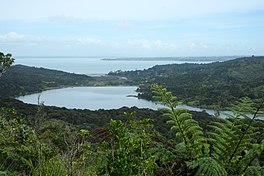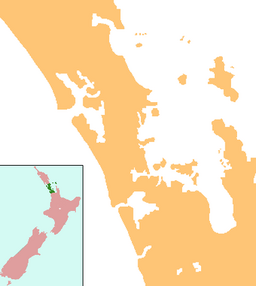The Lower Nihotupu Reservoir (or Lower Nihotupu Dam) is one of five reservoirs in the Waitākere Ranges that supply water to Auckland. Built between 1945 and 1948,[2] the reservoir covers an area of 52.9 hectares and has a capacity of 4.6 million cubic metres.[1] The reservoir is managed by Watercare Services, a council-owned company.
| Lower Nihotupu Reservoir | |
|---|---|
 Looking south, the reservoir from the Rainforest Express bush tram line. | |
| Location | Auckland, North Island |
| Coordinates | 36°57′32″S 174°36′48″E / 36.9588°S 174.6132°E |
| Type | Reservoir |
| Basin countries | New Zealand |
| Surface area | 52.9 ha (131 acres)[1] |
| Water volume | 4.60×106–4.81×106 m3 (3,730–3,900 acre⋅ft)[2][1] |
History
editThe dam is located at Paruroa, near the site of the military base of the Te Taoū hapū (subtribe) of Ngāti Whātua, who were warring with Te Waiohua, the dominant force in Tāmaki Makaurau in the early 18th century.[3][4] Years of conflict culminated in the early 1740s, when Kiwi Tāmaki, the ariki of Waiohua, was defeated at Paruroa, leading to Ngāti Whātua becoming the main political force on Tāmaki Makaurau.[3][4] Te-Rangi-hinganga-tahi, the final battle between the two forces, took place around the reservoir and Parau to the south.[5]
Earlier projects such as the Upper Nihotupu Reservoir and the Waitākere Reservoir were completed earlier in the 20th century, after a more consistent water source for Auckland was needed.[6] The Lower Nihotupu project became urgent due to the very dry summer of 1942/3, as well as increased water use by the United States Armed Forces personnel stationed in Auckland during World War II.[6] The dam is credited as one of the first applied examples of the soil mechanics science in New Zealand, and was soon followed by the creating of engineering geology as a major subject at the University of Auckland Faculty of Engineering.[2]
Recreation and access
editA walking track called Pipeline Road is found to the north of the reservoir, which includes numerous lookout points where the reservoir can be viewed from.[7]
References
edit- ^ a b c [1] (from the Water Care Services website. Accessed 2013-09-24.)
- ^ a b c Engineering to 1990 — IPENZ, Engineering Publications Co Ltd, Page 8-9
- ^ a b "The Muddy Creeks Plan - a Local Area Plan for Parau, Laingholm, Woodlands Park and Waimā" (PDF). Auckland Council. 13 February 2014. Retrieved 28 June 2021.
- ^ a b Fox, Aileen (1977). "Pa of the Auckland Isthmus: An Archaeological Analysis". Records of the Auckland Institute and Museum. 14: 1–24. ISSN 0067-0464. JSTOR 42906245. Wikidata Q58677038.
- ^ Stone, R. C. J. (2001). From Tamaki-makau-rau to Auckland. Auckland University Press. pp. 36–45. ISBN 1869402596.
- ^ a b La Roche, John (2011). "Auckland's Water Supply". In La Roche, John (ed.). Evolving Auckland: The City's Engineering Heritage. Wily Publications. pp. 27–50. ISBN 9781927167038.
- ^ Dench, Alison; Parore, Lee-Anne (2014). Walking the Waitakere Ranges: 45 Coastal and Bush Walks (4th ed.). Auckland: New Holland Publishers. pp. 38–40. ISBN 978-1-86966-426-8. OCLC 894037427. OL 30857674M. Wikidata Q123383221.
